Colloid Transport in a Single Fracture–Matrix System: Gravity Effects, Influence of Colloid Size and Density
Abstract
1. Introduction
2. Physical System
- Transport in the fracture is 1D with fluid flowing horizontally.
- Transport within the rock matrix is 1D with the transport of the fluid orthogonal to the direction of flow in the fracture.
- The fracture aperture is smaller than the length of the fracture (2b << Lf) [17].
- Transport along the fracture is faster compared to that within the porous rock matrix.
- Colloids can be transported in fracture and within rock matrix [4].
- Diffusion is the only transport mechanism within the rock matrix. Diffusion within the rock matrix is in the transverse direction (Y-axis) to that of the fracture axis (along with the X-axis) [4].
- Transverse diffusion and dispersion ensure complete mixing at all times across the fracture, and a concentration gradient does not occur across the width of the fracture [16].
- Colloids in the aqueous phase were transported advectively and dispersed in the fracture.
- Colloids were filtered (adsorbed) onto the walls of the fracture and mobile colloids may attach on to the walls of the fracture [4].
- Irreversible deposition of colloids on rock surface may occur [3].
- Colloids diffuse into the porous rock matrix from the fracture [3].
- The clogging of colloids on the fracture–matrix interface is taken care of by the percentage of matrix diffusion of colloids (ε), which is constant throughout the analysis [4].
- Gravitational force act on colloids.
3. Mathematical Model
3.1. Model for the Inclusion of the Gravitational Force
3.2. Governing Equations for the Transport in Fracture–Matrix System
3.3. Rock Penetration Length and Rock Saturation Factor
3.4. Numerical Model
4. Results and Discussion
5. Conclusions
- The gravitational force manifests a powerful control on the transport of colloidal transport by directly altering the velocity of the colloid through the fluid, and hence, altering advection and diffusion phenomena. The colloidal velocity reduces as the size of the colloid increases in the presence of the gravitational force. The reduction of colloidal velocity with the increase in the radius of colloid follows an exponential decreasing profile. This is further enhanced by an increase in colloidal density while a lower colloidal density will experience a minimum difference between the velocities of colloid and fluid. However, it was found that for a certain range of size (<50 nm) and for relatively low values of density (around 1500 kg/m3) the velocity did not reduce indicating that influence of gravity would be negligible.
- The density of colloid determines the magnitude of the impact of gravitational force on the transport of colloids. There is a limited colloid transport by the denser colloids along the fracture and within rock matrix. The influence of gravity becomes dominant as the density of colloid shifts away from that of the flowing fluid, and the gravitational influence a larger retardation of colloids for greater colloid density, enhancing the degree of gravitational settling. Roughly, 80% decrease in diffusion within the rock matrix and about 30% reduction in spatial spreading in fracture was witnessed as density increased from 1500 kg/m3 to 5000 kg/m3.
- The mass flux transfer across the fracture–matrix interface is predominantly dependent on the size of the colloid. Large size colloids face a greater obstacle at the fracture–matrix interface compared to the small size. The mass flux transfer across the interface reduces by approximately 80% when colloid size increase from 50 nm to 300 nm, and around 90% when increased from 50 nm to 600 nm. Higher mass flux transfer for 50 nm further leads to enhanced diffusion within the rock matrix compared to a scant diffusion for 300 nm and 600 nm size colloids.
- The developed non-dimensional parameter, Rock Saturation Factor (RSF) proved to be helpful in identifying the limits in terms of size and density of colloids that can penetrate deep into the rock matrix. RSF is an easy way to decide the optimum size that the colloids/suspended particle that can be transported within a fracture–matrix system to create a positive impact. The RSF will give an added advantage to the process of decision making with respect to size and density of particles before injecting in a fractured medium, especially in real-time applications such as petroleum and contamination remediation.
Author Contributions
Funding
Acknowledgments
Conflicts of Interest
References
- Champ, D.; Merritt, W.; Young, J. Potential for the rapid transport of plutonium in groundwater as demonstrated by core column studies. MRS Online Proc. Lib. Arch. 1981, 11. [Google Scholar] [CrossRef]
- Baek, I.; Pitt, W. Colloid-facilitated radionuclide transport in fractured porous rock. Waste Manag. 1996, 16, 313–325. [Google Scholar] [CrossRef]
- Abdel-Salam, A.; Chrysikopoulos, C.V. Analytical solutions for one-dimensional colloid transport in saturated fractures. Adv. Water Resourc. 1994, 17, 283–296. [Google Scholar] [CrossRef]
- Li, S.-H.; Yang, H.-T.; Jen, C.-P. Modeling of colloid transport mechanisms facilitating migration of radionuclides in fractured media. Nucl. Technol. 2004, 148, 358–368. [Google Scholar] [CrossRef]
- Silveira, C.S.; Alvim, A. Numerical Modeling of Radionuclide Migration in Water-Saturated Planar Fracture: Study of Performance of Bentonite in the Far-Field Region; International Atomic Energy Agency (IAEA): Vienna, Austria, 2011. [Google Scholar]
- Elimelech, M. Effect of particle size on the kinetics of particle deposition under attractive double layer interactions. J. Colloid Interface Sci. 1994, 164, 190–199. [Google Scholar] [CrossRef]
- Ryan, J.N.; Elimelech, M. Colloid mobilization and transport in groundwater. Colloids Surf. A Physicochem. Eng. Asp. 1996, 107, 1–56. [Google Scholar] [CrossRef]
- Chang, Y.-I.; Ku, M.-H. Gravity-induced flocculation of non-brownian particles. Colloids Surf. A Physicochem. Eng. Asp. 2001, 178, 231–247. [Google Scholar] [CrossRef]
- Cumbie, D.; McKay, L. Influence of diameter on particle transport in a fractured shale saprolite. J. Contam. Hydrol. 1999, 37, 139–157. [Google Scholar] [CrossRef]
- James, S.C.; Chrysikopoulos, C.V. Monodisperse and polydisperse colloid transport in water-saturated fractures with various orientations: Gravity effects. Adv. Water Resour. 2011, 34, 1249–1255. [Google Scholar] [CrossRef]
- Kretzschmar, R.; Barmettler, K.; Grolimund, D.; Yan, Y.-D.; Borkovec, M.; Sticher, H. Experimental determination of colloid deposition rates and collision efficiencies in natural porous media. Water Resour. Res. 1997, 33, 1129–1137. [Google Scholar] [CrossRef]
- James, S.C.; Chrysikopoulos, C.V. Dense colloid transport in a bifurcating fracture. J. Colloid Interface Sci. 2004, 270, 250–254. [Google Scholar] [CrossRef] [PubMed]
- Chrysikopoulos, C.V.; Syngouna, V.I. Effect of gravity on colloid transport through water-saturated columns packed with glass beads: Modeling and experiments. Environ. Sci. Technol. 2014, 48, 6805–6813. [Google Scholar] [CrossRef] [PubMed]
- Abhishek, R.; Bagalkot, N.; Kumar, G.S. Effect of transverse forces on velocity of nanoparticles through a single fracture in a fractured petroleum reservoir. Int. J. Oil Gas Coal Technol. 2015, 12, 379–395. [Google Scholar] [CrossRef]
- Unni, H.; Yang, C. Brownian dynamics simulation and experimental study of colloidal particle deposition in a microchannel flow. J. Colloid Interface Sci. 2005, 291, 28–36. [Google Scholar] [CrossRef] [PubMed]
- Jen, C.-P.; Li, S.-H. Effects of hydrodynamic chromatography on colloid-facilitated migration of radionuclides in the fractured rock. Waste Manag. 2001, 21, 499–509. [Google Scholar] [CrossRef]
- Sudicky, E.; Frind, E. Contaminant transport in fractured porous media: Analytical solutions for a system of parallel fractures. Water Resour. Res. 1982, 18, 1634–1642. [Google Scholar] [CrossRef]
- Bowen, B.D.; Epstein, N. Fine particle deposition in smooth parallel-plate channels. J. Colloid Interface Sci. 1979, 72, 81–97. [Google Scholar] [CrossRef]
- Grisak, G.; Pickens, J.-F. Solute transport through fractured media: 1. The effect of matrix diffusion. Water Resour. Res. 1980, 16, 719–730. [Google Scholar] [CrossRef]
- Sivasankar, P.; Kumar, G.S. Numerical modelling of enhanced oil recovery by microbial flooding under non-isothermal conditions. J. Pet. Sci. Eng. 2014, 124, 161–172. [Google Scholar] [CrossRef]
- Bagalkot, N.; Zare, A.; Kumar, G.S.J.E. Influence of fracture heterogeneity using linear congruential generator (lcg) on the thermal front propagation in a single geothermal fracture-rock matrix system. Energies 2018, 11, 916. [Google Scholar] [CrossRef]
- James, S.C.; Chrysikopoulos, C.V. Analytical solutions for monodisperse and polydisperse colloid transport in uniform fractures. Colloids Surf. A Physicochem. Eng. Asp. 2003, 226, 101–118. [Google Scholar] [CrossRef]

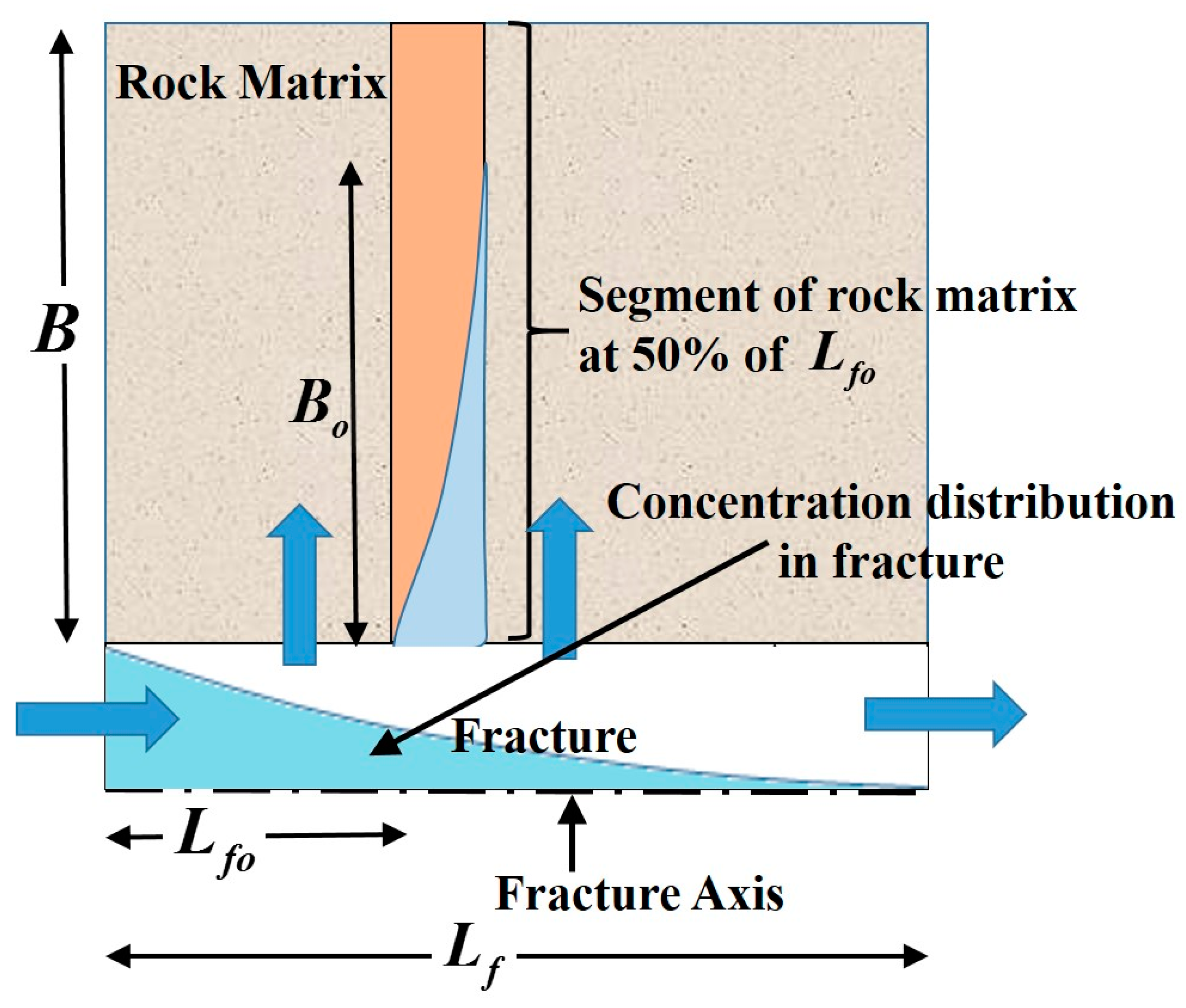

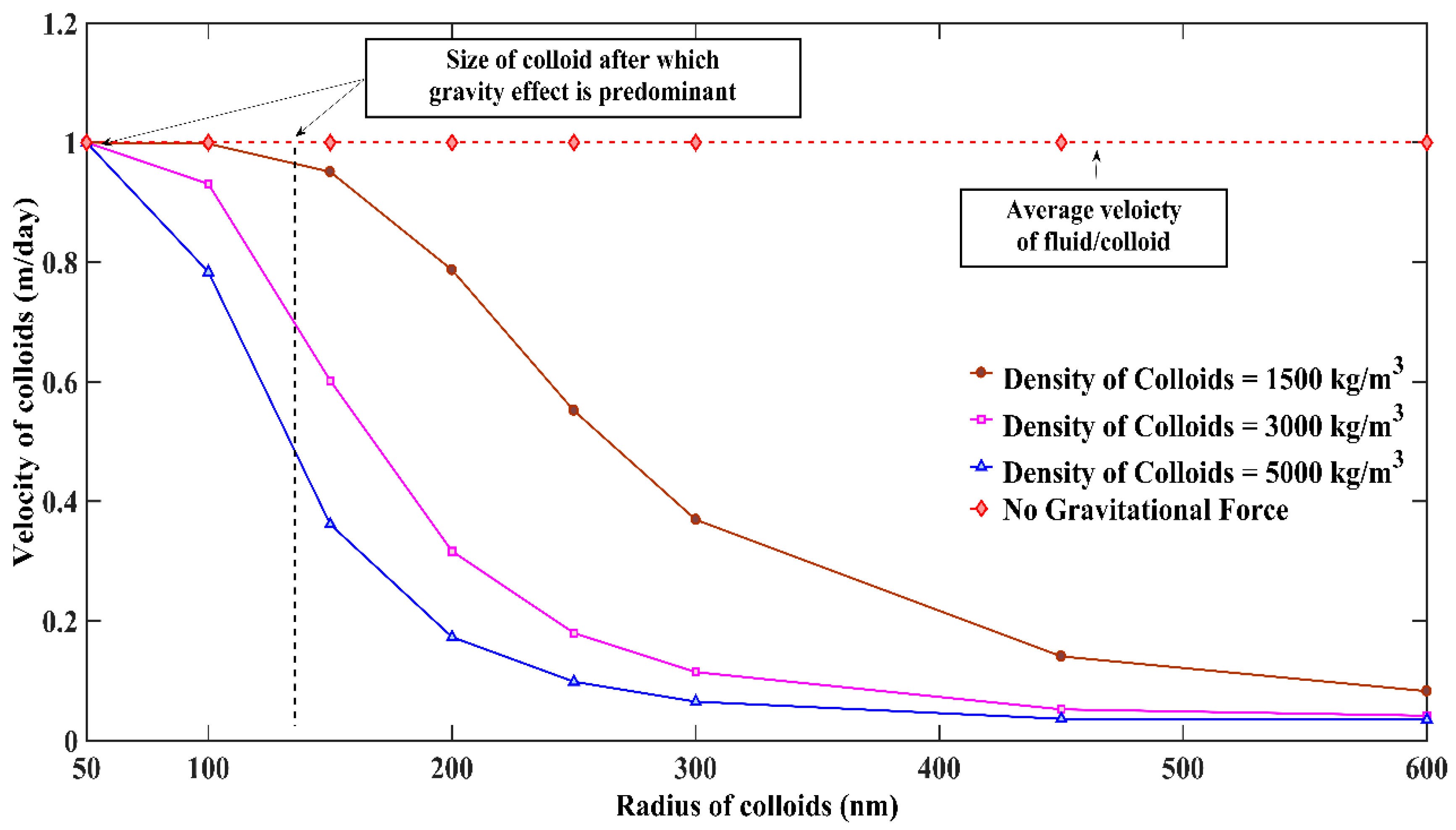
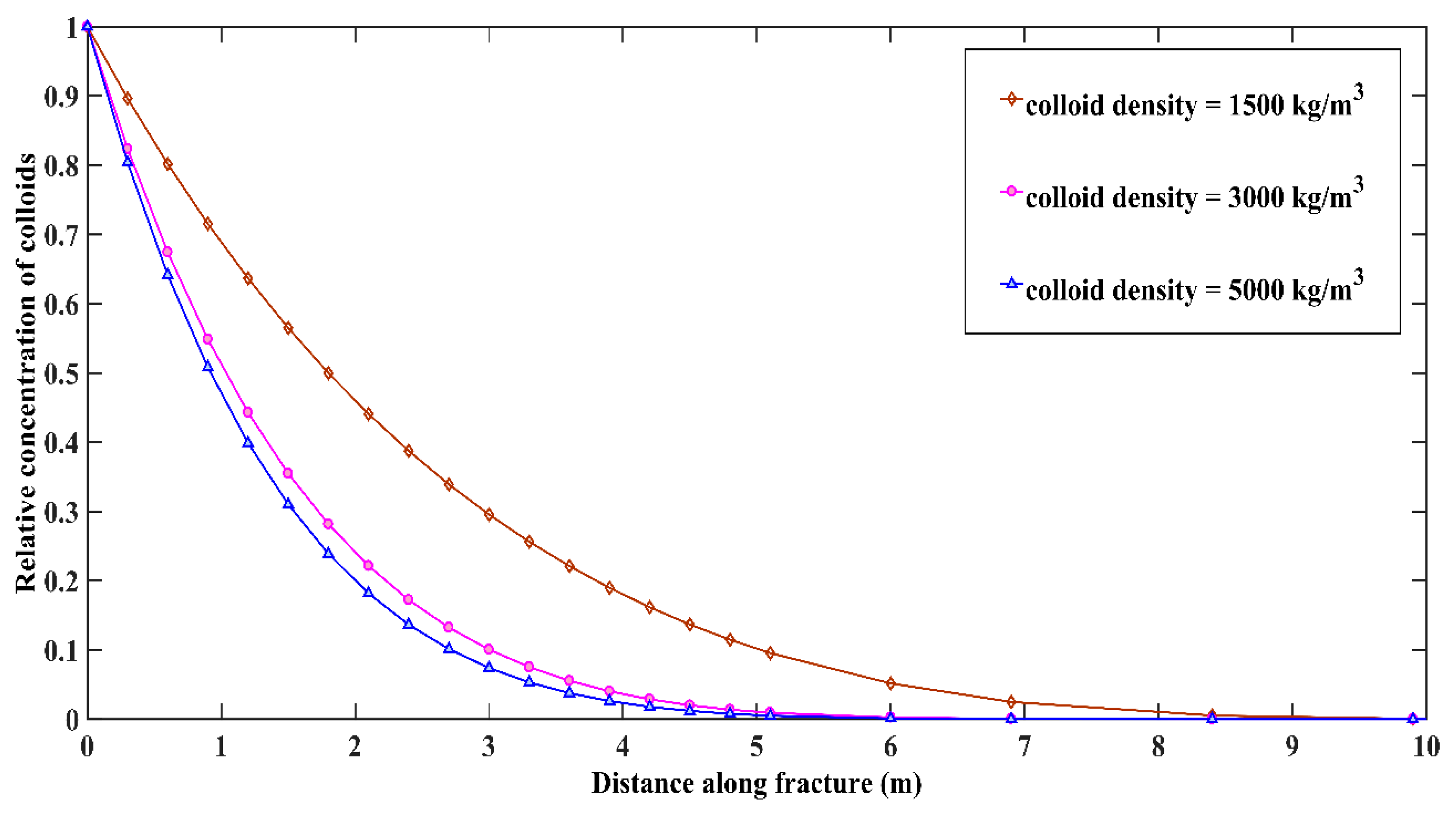
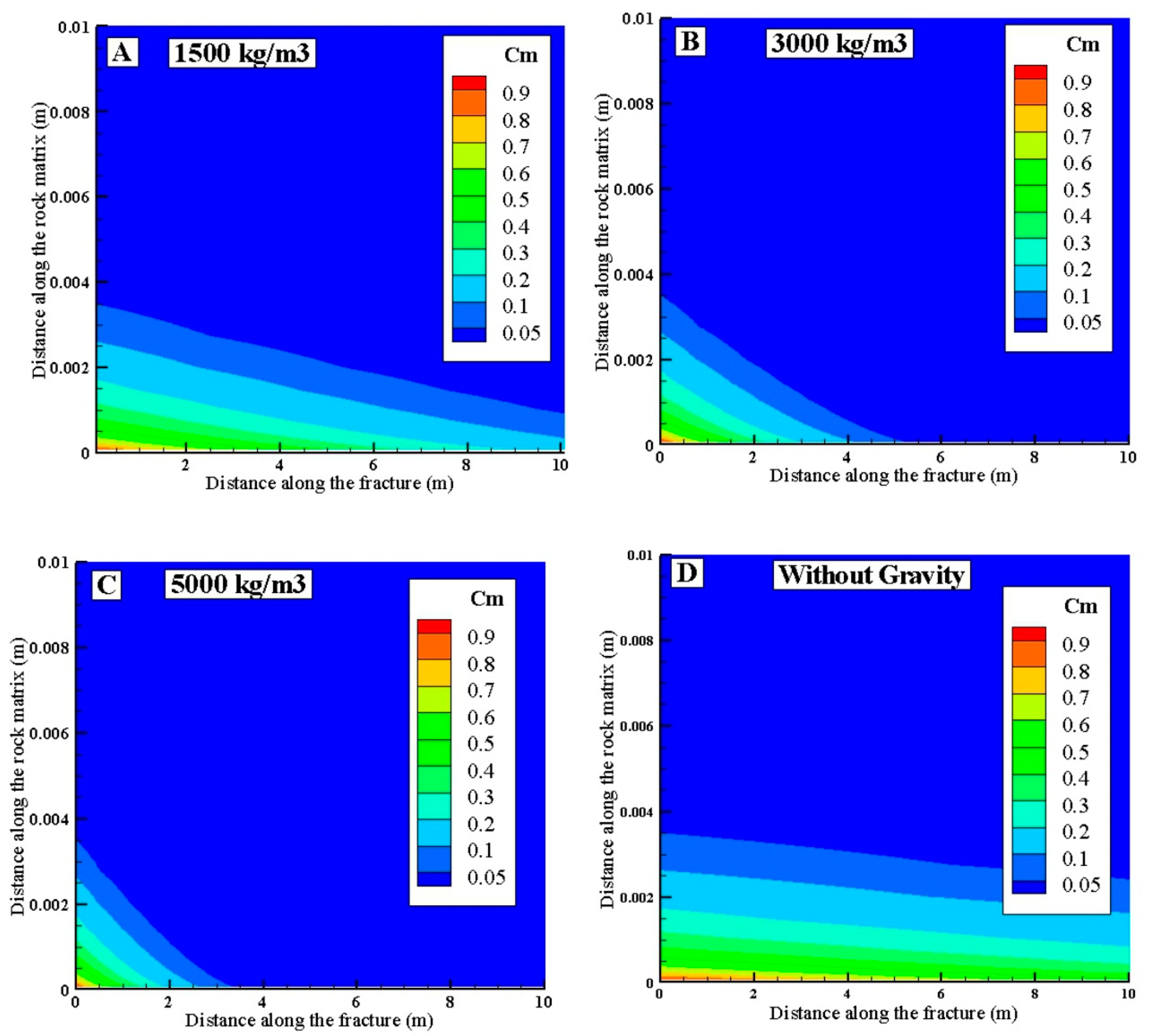

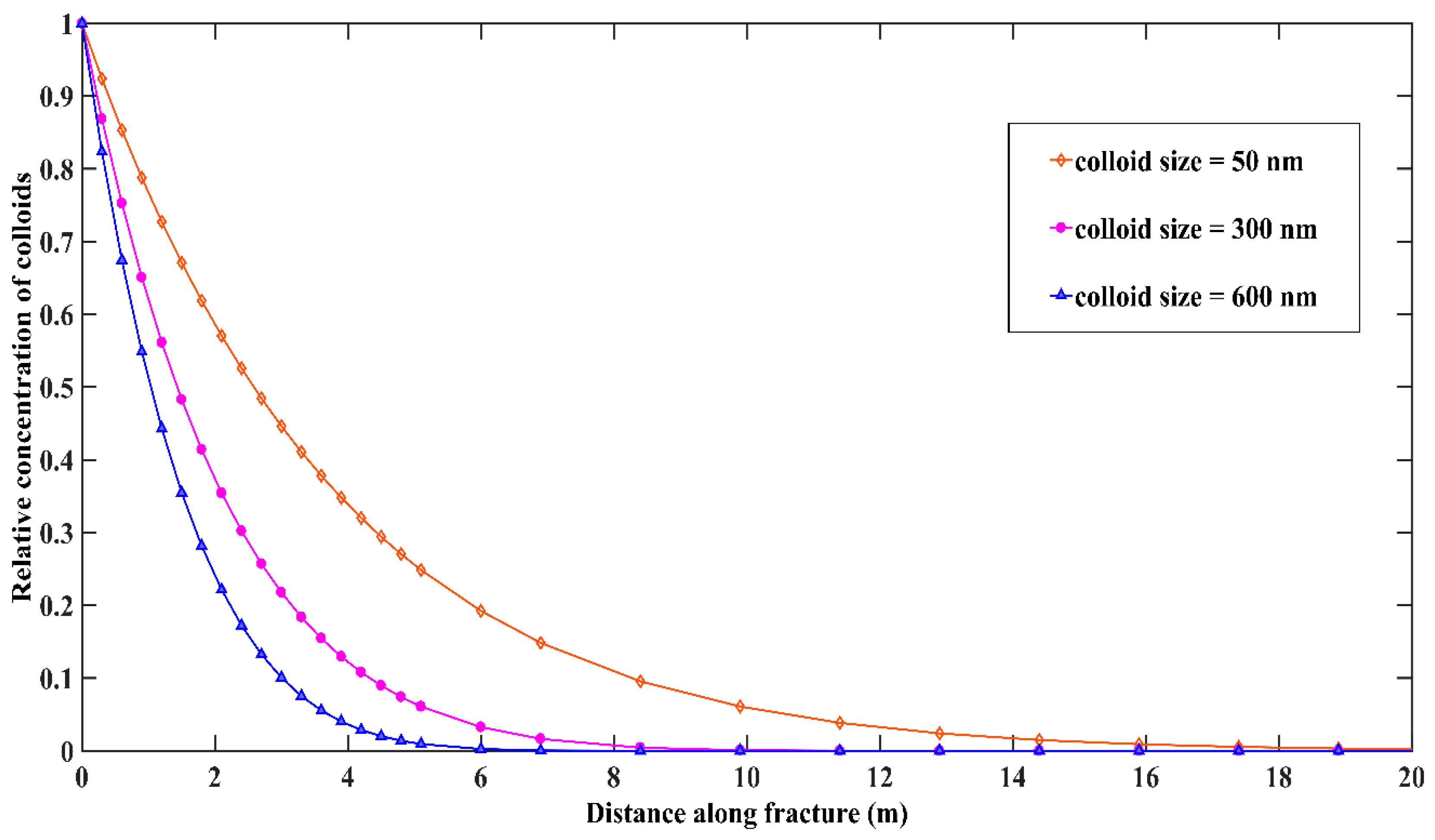
| Parameter | Value | Reference |
|---|---|---|
| Spatial grid size along the fracture, ∆x (m) | 0.006 | Calculated |
| Time step size. ∆t (days) | 0.005 | Calculated |
| Length of fracture, L (m) | 20 | Assumed |
| Thickness of rock matrix, B (m) | 0.25 | Assumed |
| Total time of simulation, T (days) | 100 | Assumed |
| Half fracture aperture (Parallel Plate Model), b (μm) | 50 | Assumed |
| Sorption partition coefficient for colloids in rock matrix, Kdm | 0.2 | [4] |
| Percentage of matrix diffusion flux of colloids, ε (0–1) | 0.1 | [4] |
| Porosity of rock matrix, θ | 0.03 | [4] |
| Hydrodynamic dispersion coefficient of colloids suspended in fracture, (m2/day) | 0.013 | [4] |
| Density of water, (kg/m3) | 1000 | |
| Average velocity of the colloids’ particles, (absence of gravity) (m/day) | 1 | Assumed |
| Fluid flow rate, Q (m3/day) | 50 × 10−6 | Q = A·Vc |
| Filtration coefficient of the colloids in fracture, , (L/m) | 0.3 | [4] |
| Density of colloids, ρc (kg/m3) | 1500–5000 | [4] |
| Radius of colloids, (nm) | 50–600 | [4] |
| Boltzmann’s constant, (J/K) | 1.38 × 10−23 | [4] |
| Size of Colloid (nm) | De (m2/day) | Coupling Coefficient (m/day) |
|---|---|---|
| 50 | 3.29 × 10−7 | 6.57 × 10−4 |
| 300 | 0.65 × 10−7 | 1.31 × 10−4 |
| 600 | 0.27 × 10−7 | 0.54 × 10−4 |
| Colloid Size (nm) | Colloid Density (kg/m3) | ||
|---|---|---|---|
| 1500 | 3000 | 5000 | |
| Rock Saturation Factor | Rock Saturation Factor | Rock Saturation Factor | |
| 50 | 0.214 | 0.214 | 0.214 |
| 300 | 0.156 | 0.122 | 0.112 |
| 600 | 0.112 | 0.100 | 0.075 |
© 2018 by the authors. Licensee MDPI, Basel, Switzerland. This article is an open access article distributed under the terms and conditions of the Creative Commons Attribution (CC BY) license (http://creativecommons.org/licenses/by/4.0/).
Share and Cite
Bagalkot, N.; Kumar, G.S. Colloid Transport in a Single Fracture–Matrix System: Gravity Effects, Influence of Colloid Size and Density. Water 2018, 10, 1531. https://doi.org/10.3390/w10111531
Bagalkot N, Kumar GS. Colloid Transport in a Single Fracture–Matrix System: Gravity Effects, Influence of Colloid Size and Density. Water. 2018; 10(11):1531. https://doi.org/10.3390/w10111531
Chicago/Turabian StyleBagalkot, Nikhil, and G. Suresh Kumar. 2018. "Colloid Transport in a Single Fracture–Matrix System: Gravity Effects, Influence of Colloid Size and Density" Water 10, no. 11: 1531. https://doi.org/10.3390/w10111531
APA StyleBagalkot, N., & Kumar, G. S. (2018). Colloid Transport in a Single Fracture–Matrix System: Gravity Effects, Influence of Colloid Size and Density. Water, 10(11), 1531. https://doi.org/10.3390/w10111531





